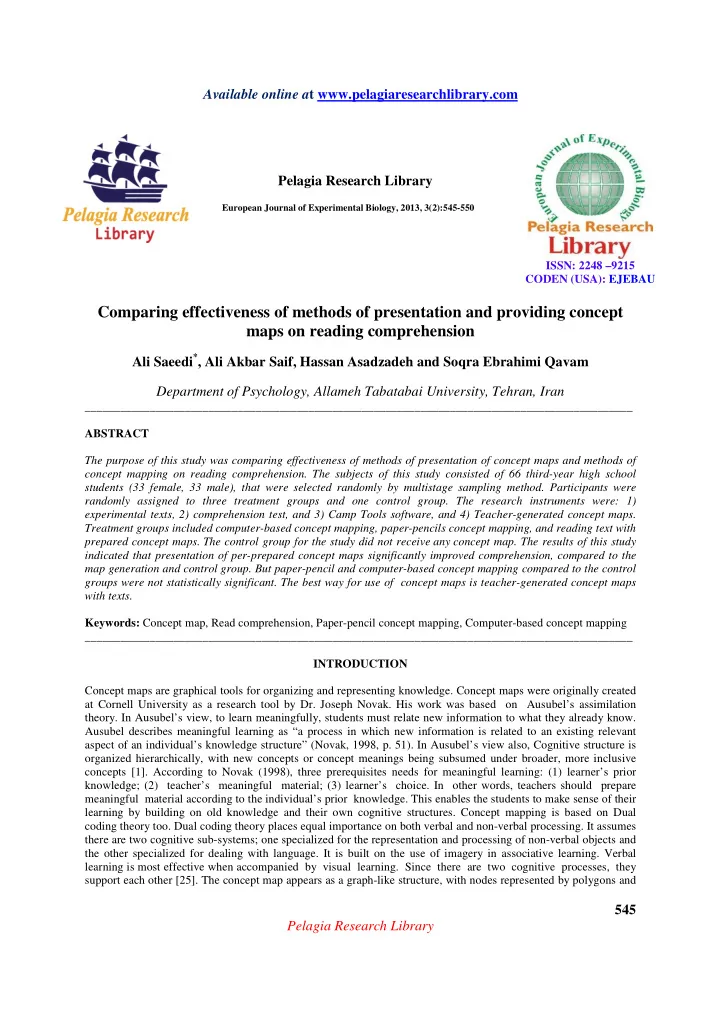

Available online a t www.pelagiaresearchlibrary.com Pelagia Research Library European Journal of Experimental Biology, 2013, 3(2):545-550 ISSN: 2248 –9215 CODEN (USA): EJEBAU Comparing effectiveness of methods of presentation and providing concept maps on reading comprehension Ali Saeedi * , Ali Akbar Saif, Hassan Asadzadeh and Soqra Ebrahimi Qavam Department of Psychology, Allameh Tabatabai University, Tehran, Iran _____________________________________________________________________________________________ ABSTRACT The purpose of this study was comparing effectiveness of methods of presentation of concept maps and methods of concept mapping on reading comprehension. The subjects of this study consisted of 66 third-year high school students (33 female, 33 male), that were selected randomly by multistage sampling method. Participants were randomly assigned to three treatment groups and one control group. The research instruments were: 1) experimental texts, 2) comprehension test, and 3) Camp Tools software, and 4) Teacher-generated concept maps. Treatment groups included computer-based concept mapping, paper-pencils concept mapping, and reading text with prepared concept maps. The control group for the study did not receive any concept map. The results of this study indicated that presentation of per-prepared concept maps significantly improved comprehension, compared to the map generation and control group. But paper-pencil and computer-based concept mapping compared to the control groups were not statistically significant. The best way for use of concept maps is teacher-generated concept maps with texts. Keywords: Concept map, Read comprehension, Paper-pencil concept mapping, Computer-based concept mapping _____________________________________________________________________________________________ INTRODUCTION Concept maps are graphical tools for organizing and representing knowledge. Concept maps were originally created at Cornell University as a research tool by Dr. Joseph Novak. His work was based on Ausubel’s assimilation theory. In Ausubel’s view, to learn meaningfully, students must relate new information to what they already know. Ausubel describes meaningful learning as “a process in which new information is related to an existing relevant aspect of an individual’s knowledge structure” (Novak, 1998, p. 51). In Ausubel’s view also, Cognitive structure is organized hierarchically, with new concepts or concept meanings being subsumed under broader, more inclusive concepts [1]. According to Novak (1998), three prerequisites needs for meaningful learning: (1) learner’s prior knowledge; (2) teacher’s meaningful material; (3) learner’s choice. In other words, teachers should prepare meaningful material according to the individual’s prior knowledge. This enables the students to make sense of their learning by building on old knowledge and their own cognitive structures. Concept mapping is based on Dual coding theory too. Dual coding theory places equal importance on both verbal and non-verbal processing. It assumes there are two cognitive sub-systems; one specialized for the representation and processing of non-verbal objects and the other specialized for dealing with language. It is built on the use of imagery in associative learning. Verbal learning is most effective when accompanied by visual learning. Since there are two cognitive processes, they support each other [25]. The concept map appears as a graph-like structure, with nodes represented by polygons and 545 Pelagia Research Library
Ali Saeedi et al Euro. J. Exp. Bio., 2013, 3(2):545-550 _____________________________________________________________________________ lines joining them together. The nodes represent a central concept or idea, while the lines connecting the nodes represent a link or relationship between two concepts. Nodes are labeled by the concept they represent and the links are labeled according to the relationship between the two concepts they connect. Figure1. Show a Concept Map about CmapTools that prepare whit Cmap Tools software. When constructing a concept map, the concept mapper first selects key concepts from a topic. Then he or she prioritizes the concepts such that the most inclusive concept is listed first and the least inclusive listed last. The concept map is arranged according the hierarchical list and the concepts are linked with appropriate words to describe the relationship between the concepts. Finally, the concept mapper inserts crosslinks, connecting different vertical threads of the concept map. The crosslinking step is important for showing an integrated understanding of the various aspects of the topic [15]. Figure 1. Concept Map about CmapTools (from http://cmap.ihmc.us) Concept maps in teaching positions and in the teaching - learning process can be used in various ways. According to who will prepare a concept map or concept map of what the teacher and student in the manufacturing process, they are divided into two categories: Teacher-generated concept map and Student-generated concept map. However, the proportion of teachers in teacher-made maps, and maps can also be varied to provide full or partial hallmarks to be provided to students and they are asked to complete the map. The traditional way of constructing concept maps uses paper and pencil. But with the rapid development of Information and Communication Technologies, a number of computer-assisted concept mapping systems have been proposed [6]. Basis on the instrument used in making maps, concept mapping process can be categorized in two ways: Paper-pencil concept mapping (construction of concept maps on paper by hand) and computer-based concept mapping (concept mapping by special software). Basis on numbers of people involved in the concept mapping process, there are two ways for building a concept map: Individual concept mapping and Collaborative concept mapping.In the individual concept mapping one person builds or completes a concept map. A Concept map that made by a student, indicates the student's understanding of that issue [2]. The Student who is involved in the self-discussion of concept mapping, has the additional benefit. In contrast, concept mapping provides multiple individual views and experiences and the representation of knowledge is extensive. Collaborative concept mapping occurs when two or more people actively involved in the process of 546 Pelagia Research Library
Recommend
More recommend